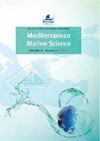水文屏障、古气候和生命史对海洋种群遗传结构的交织影响:以两种海洋无脊椎动物为例
IF 2.3
3区 环境科学与生态学
Q1 MARINE & FRESHWATER BIOLOGY
引用次数: 0
摘要
具有浮游幼体阶段的海洋生物具有很高的扩散潜力,但其范围受到当前和历史地理和海洋学特征的限制。水文地理特征,如海峡和水流模式,以及古气候可以影响种群连通性、遗传分化,并最终影响物种形成,但物种分布也受到生命史特征的影响。本研究使用线粒体和核标记(M.galloprovincialis的微卫星和P.elegans的组蛋白H3基因)评估了土耳其海峡系统(TSS)对具有浮游幼虫的两种底栖无脊椎动物(地中海贻贝Mytilus galloprovencialis和岩池对虾Palaemon elegans)的遗传分化的影响。对于这两个物种,线粒体DNA分析将黑海和东地中海(爱琴海和黎凡特海)种群分为两个集群。相反,在这两个物种中,核数据表明黑海和东地中海种群之间没有差异。结果表明,对于这两个物种来说,一些起源于黑海的个体向南移动,很可能是通过TSS的表面洋流运输其远洋幼虫。然而,在大多数情况下,地中海起源的个体(来自爱琴海和黎凡特海)无法成功地向相反的方向迁徙,尽管向这个方向迁徙频率的微小差异表明了这两个物种的生活史特征对遗传结构的影响。本文章由计算机程序翻译,如有差异,请以英文原文为准。
The Intertwined Effects of Hydrographic Barriers, Palaeoclimate and Life History on Genetic Structure of Marine Populations: A Case Study of Two Marine Invertebrates
Marine organisms with pelagic planktonic larval stages have high dispersal potential, yet their ranges are restricted by present and historical geographic and oceanographic features. Hydrogeographic features, such as straits and water current patterns, as well as paleoclimate can affect population connectivity, genetic differentiation, and ultimately speciation, but species distributions are also affected by life history characteristics. This study evaluates the effect of the Turkish Straits System (TSS) on the genetic differentiation of two benthic invertebrates with pelagic larvae, the Mediterranean mussel, Mytilus galloprovincialis, and the rockpool prawn, Palaemon elegans, using mitochondrial and nuclear markers (microsatellites for M. galloprovincialis and Histone H3 gene for P. elegans). For both species, the mitochondrial DNA analyses separated the Black Sea and the Eastern Mediterranean (Aegean and Levantine seas) populations into two clusters. In contrast, in both species the nuclear data indicated no differentiation between Black Sea and Eastern Mediterranean populations. The results suggest that for both species, some individuals of Black Sea origin moved south, most likely through the transport of their pelagic larvae via the surface currents of the TSS. However, for the most part, individuals of Mediterranean origin (from Aegean and Levantine seas) were not able to successfully migrate in the opposite direction, though the small differences in the frequencies of migration in this direction indicate the effects of the life history characteristics of the two species on genetic structure.
求助全文
通过发布文献求助,成功后即可免费获取论文全文。
去求助
来源期刊

Mediterranean Marine Science
MARINE & FRESHWATER BIOLOGY-
CiteScore
5.20
自引率
17.90%
发文量
34
审稿时长
>12 weeks
期刊介绍:
The journal Mediterranean Marine Science (MMS), published by the Hellenic Centre for Marine Research (HCMR), issues three volumes annually. The journal welcomes original research articles, short communications, New Mediterranean Biodiversity records, extended reviews, comments, and Theme sections in all fields of Oceanography, Marine Biology, Marine Conservation, Fisheries and Aquaculture in the Mediterranean area and the adjacent regions. All content is peer reviewed.
 求助内容:
求助内容: 应助结果提醒方式:
应助结果提醒方式:


